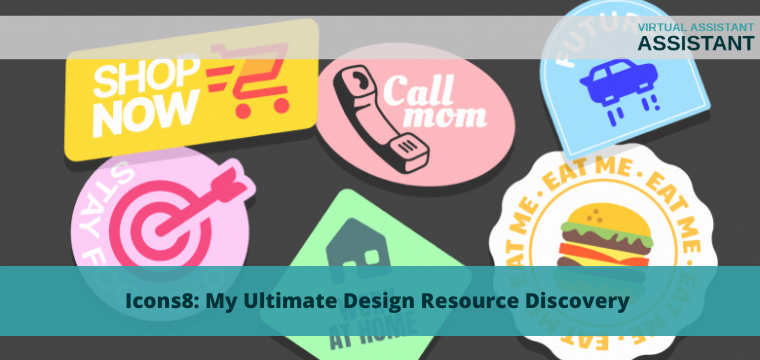Icons8: My Ultimate Design Resource Discovery
 The Day My Icons Got Brutally Exposed
The Day My Icons Got Brutally Exposed
Two weeks ago, I presented this web interface design to a client’s UX team. Their lead designer – an incredibly sharp woman – stops my demo and says, “These UI elements feel inconsistent. Like you sourced them from different design libraries.”
Damn. She was right. I’d grabbed navigation arrows from Phosphor, interaction buttons from Heroicons, and interface controls from some random Figma community resource. Each looked fine individually, but as a complete web interface? Complete mess.
The frustrating thing? I’ve been designing web interfaces for years. Still making the same amateur mistake – collecting icons from six different libraries and somehow expecting visual harmony. Doesn’t work. Never has.
That feedback got under my skin. Spent my weekend digging for solutions instead of my usual gaming routine. That’s when I stumbled onto Icons8. The first impression was, “Oh great, another platform boasting about millions of icons.” But testing it? Completely different story.
Icons8’s Genius Approach to Visual Unity
Most icon platforms categorize everything. “Web icons.” “Interface icons.” Standard approach. Icons8 did something way more innovative – they built complete visual ecosystems. 45 different families where every single icon works together.
Real example: this dashboard interface I just finished. Needed navigation controls, data visualization, user management, interaction feedback, and progress indicators. Used their “iOS Filled” style, and everything clicked beautifully—same visual DNA throughout – matching stroke weights, identical corner treatments, unified aesthetic language. Usually takes weeks hunting for matching icons. This time? One day.
Their SVG code doesn’t suck either—clean structure, sensible naming, no bizarre nested chaos. Animation and path editing become logical instead of frustrating.
Format Coverage That Helps
PNG, SVG, PDF, EPS, PSD, AI – they deliver everything. Matters because real projects need different formats. Web developers want SVGs. Print people need EPS. Quick mockups use PNG. Mobile teams need multiple sizes.
One source beats constantly jumping between vendors. They understand platform quirks, too. iOS has specific visual rules. Android does things differently. Desktop apps require a similar approach: the same icon concept, but with different execution for each platform.
API That Doesn’t Break Down
Their REST API works reliably. I’ve used it on perhaps a dozen projects, and I’ve never had any major failures. Dynamic icon switching based on user preferences? Runs smoothly. Performance problems? Haven’t seen any.
Documentation includes real examples that compile correctly. Revolutionary concept, right? The API handles icons, illustrations, photos, and music through a single endpoint. Makes complex integrations much easier.
Plugin Integration That Works
Figma plugin puts over a million assets right in your workspace. No more tab switching hell. No file management nightmares. No “where did I save that icon” moments.
Working on interactive web interfaces requires precise UI elements, such as custom cursor icons and other interaction symbols. Everything maintains a consistent behavioral design across all interface components. Makes the whole user experience feel intentional instead of thrown together.
The productivity jump is real. Used to bookmark twenty icon sites, constantly breaking focus. Now everything lives where I’m already working.
AI Tools That Don’t Disappoint
Smart Upscaler, Background Remover, Face Swapper sound like marketing bullshit. They’re practical. Background remover often beats Photoshop. Clean edges, natural separation.
Smart Upscaler saved my ass recently. The client provided outdated interface assets that appeared poorly at the required sizes. Ran them through Icons8 – perfect results at any scale. Quick processing, too.
Image search works well. Upload interface screenshots and receive relevant iconography suggestions. Upload dashboard mockups and obtain UI symbols. Simple but effective.
Who Gets Value
Big Companies
Enterprise teams struggle with consistency across products. Scattered icons create maintenance nightmares. Icons8’s systematic approach significantly reduces costs. Tech teams love clean code and predictable naming. Saves significant time on large implementations.
Schools and Students
Free tier with attribution works great for education. Students build professional projects without budget stress. Style libraries teach consistency principles effectively.
Startups
Limited resources make hiring icon specialists impossible. Time savings alone justify subscription costs—professional aesthetics without professional budgets.
The Annoying Stuff
Money Issues
$13 monthly starting point. Suitable for established professionals, but challenging for freelancers or students just starting out. The free tier covers some cases, but serious work requires paid access.
Support Is Garbage
Customer service consistently disappoints. Billing problems drag on forever. Getting responses takes ages. Need reliable vendor support? This will frustrate you.
Illustration Gaps
Icons are comprehensive. Illustrations? Pretty sparse across most styles. Need extensive custom illustration work? You’ll need other sources.
Technical Performance
Works on all platforms: web, Mac, Windows, and Linux. Offline mode helps when internet craps out. Performance stays solid during heavy usage. Doesn’t slow your system down.
SVG quality needs minimal cleanup compared to competitors. Naming follows logical patterns. Implementation becomes straightforward.
Making It Work for Your Team
Design Teams
Best value when consistency matters across big projects. Building design systems? Maintaining brand coherence across touchpoints? Immediate efficiency gains.
Setting up an investment pays off through less maintenance and faster iterations.
Development Teams
Clean code standards, predictable organization, and reliable API. These directly impact development speed and app performance.
Education
Great for teaching systematic design while giving students professional resources.
The Bottom Line
Icons8 went from a basic icon library to an essential design infrastructure. Support issues and pricing might be dealbreakers for some, but the core product solves real workflow problems.
Main strength: systematic consistency plus solid technical execution. Care about efficiency and quality? This scales nicely across different project types.
Traditional icon hunting across random sites feels outdated now. This approach works better for maintaining consistent design quality.
The platform isn’t perfect – nothing is. But it solved my biggest workflow problem: finding icons that belong together. For web interface designers, that’s incredibly valuable.
Been using it for months. Can’t imagine going back to the scattered approach. Sometimes you find tools that click with your workflow. This is one of those.
